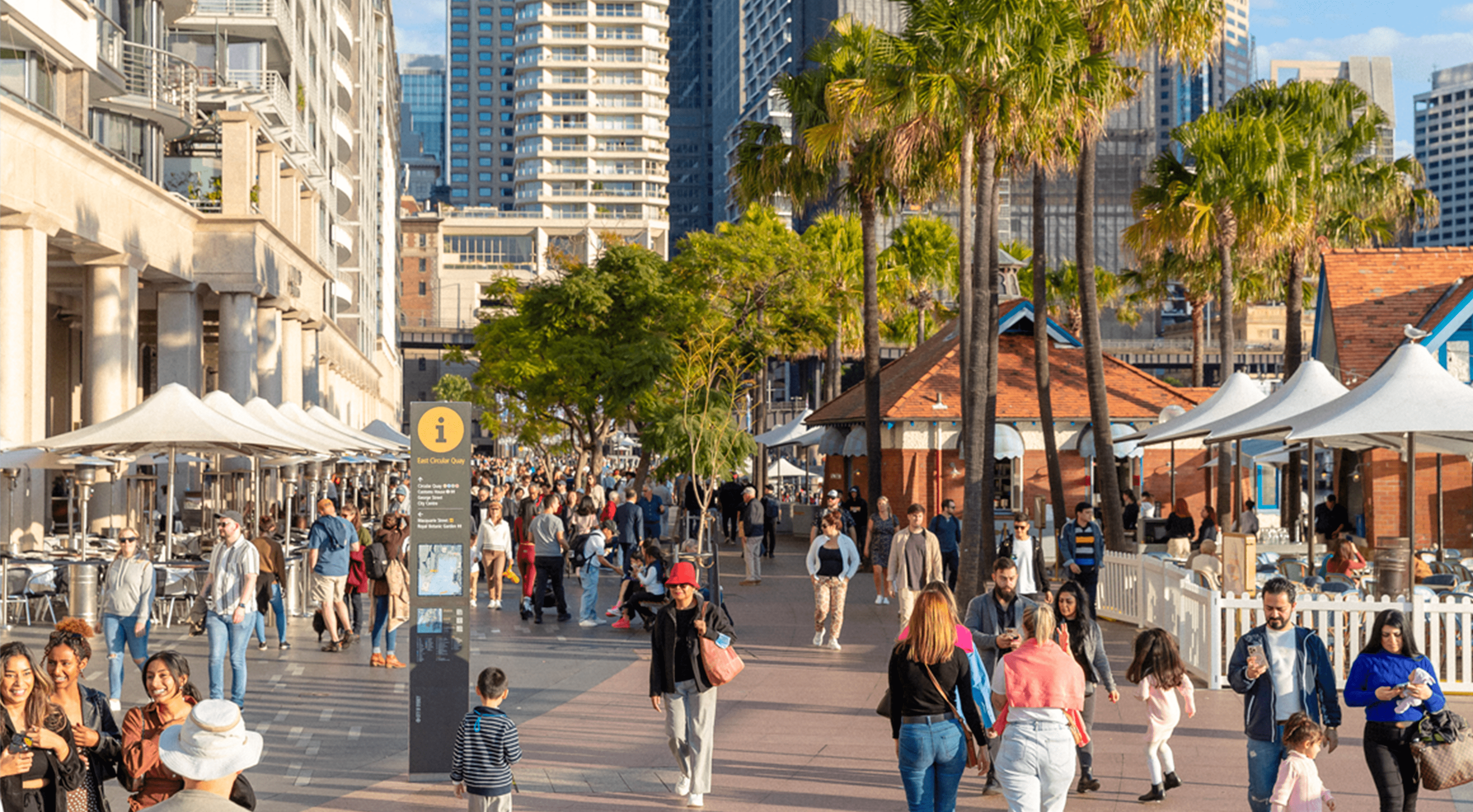Features > Property News & Insights > In-Depth Analyses
Weak economy being kept alive by migration and government spending
.png)
KEY POINTS
- Figures from the ABS show the Australian economy grew by just 0.2% in seasonally adjusted terms during the June quarter and by 1.5% in the 2023-24 financial year
- Apart from the COVID-19 pandemic, it’s the weakest annual growth since 1991-92
- Per capita GDP has also experienced its sixth straight quarter of negative growth
- Analysts say the figures show the only factors that are stopping Australia tipping into recession are population growth - mainly from immigration - and government spending
- However, both these growth factors have implications for housing, with population pressures putting more demand on the already under-supplied sector and big government projects sucking up construction workers who could help to ease the housing shortage
New economic growth data from the Australian Bureau of Statistics (ABS) has underlined the parlous state of the Australian economy, which has chalked up the weakest annual growth in more than 30 years—excluding the Covid pandemic period.
The ABS says the nation’s Gross Domestic Product (GDP) rose 0.2% in the quarter ending June 30th 2024, roughly in line with market expectations.
The details
After some revision to previous data, the ABS concluded that the economy grew just 1% in 2023-24, “the weakest annual growth (excluding the COVID-19 pandemic) since 1991-92, a year that included the gradual recovery from the 1991 recession.”
The Bureau says, “The weak growth reflects subdued household demand, which detracted 0.1 percentage points from GDP growth while government consumption contributed 0.3 percentage points.”
In other words, confirmation that households have tightened their belts as a cost of living crisis continues, while it’s government spending that is helping to prop up demand in the economy.
“I think the key point here is the economy, certainly in the quarter, was just crawling, barely crawling,” says BetaShares Chief Economist David Bassanese, “...consumer spending - very weak.”
“Government spending has been the main prop in the quarter.”
The problem is that much of this large amount of government spending has come in the form of big infrastructure projects, which have sucked scarce construction workers out of the residential building sector at a time of heightened demand for housing.
Population growth:
In fact, if you calculate GDP per capita or per person, growth has been going backwards (and Australia has been in a recession) for six quarters, which explains why individuals and households feel so stretched, even though the data tells us that as a whole, the country is moving ahead.
The reason is that population growth is still high, coming in at 547,000 people in the year to December 2023, according to the ABC.
“Australia’s population continues to grow aggressively through net overseas migration,” says Leith Van Onselen, Chief Economist at MB Fund and MB Super.
“The population increased by 0.6% in Q2, meaning that per capita GDP declined by another 0.4%.”
“Population is the one thing that's been holding the economy up, really, and driving overall growth,” says independent economist Nicki Hutley.
While the rate of migration is slowing, it’s still high, particularly at a time when there's a housing crisis.
And interest rates being kept high by the Reserve Bank—in a bid to bring down inflation—is not helping.
“The two things…taking it on the chin, so to speak, is consumer spending by domestic residents - very weak, and housing construction, which is a real shame because we know about the housing shortages,” says BetaShares David Bassanese.
“But they are the key things holding back the economy and bearing the brunt of the higher interest rate policy at the moment,” he told the ABC.
Developers have shelved many builds, saying the high interest rate environment, coupled with high construction costs exacerbated by material and labour shortages, is making many high-density housing projects unviable.
Interest rates
So, what do the weak growth figures mean for interest rates and Australians suffering from high mortgage interest payments?
David Bassanese, for one, doesn’t think it adds to the case “for a rate cut anytime soon.”
Independent economist Michael Blythe goes further, saying he believes “the RBA will be concerned about the continued strength in public spending and rapid growth in unit labour costs given their concerns about “sticky” services inflation” and that “rate cuts are unlikely until the RBA sees more progress on slowing inflation.”
The takeout
The latest growth figures paint a gloomy picture of the economy and the prospects for a significant pick-up in housing construction.
However, despite the government kerbing the numbers of international students and the opposition pledging to cut 40,000 places out of the annual permanent migration program if elected, don’t expect net migration to fall drastically.
“At a time when two-thirds of the OECD have seen their economy go backwards, at least one quarter, we haven't done that,” said Treasurer Jim Chalmers in a press conference responding to the GDP figures.
“In that context, in the context of a really difficult global economic environment, any growth in our economy is welcome growth.”
No Australian government wants to preside over a recession and be tagged as a bad economic manager, and one of the key factors keeping Australia afloat is overseas migration—more people coming into the country and spending money on goods and services.
It’s good news for the economy but will only exacerbate the current housing crisis.
Stay Up to Date
with the Latest Australian Property News, Insights & Education.




.png?width=292&height=292&name=Copy%20Link%20(1).png)
 SIGN UP FOR FREE NEWSLETTER
SIGN UP FOR FREE NEWSLETTER
%20(1).png)







.jpg?width=1920&height=1080&name=Warning%2c%20You%20Might%20Be%20Facing%20Higher%20Taxes%20Soon%20(1).jpg)





.png?width=1920&height=1080&name=Rate%20Drops%20Signal%20BIGGEST%20Property%20Boom%20in%20DECADES%20(1).png)

.jpg?width=1920&height=1080&name=Labor%20vs%20Liberal%20These%20Housing%20Policies%20Could%20Change%20the%20Property%20Market%20Forever%20(1).jpg)
.jpg?width=1920&height=1080&name=QLD%20Slashes%20Stamp%20Duty%20Big%20News%20for%20Investors%20%26%20Home%20Buyers%20(1).jpg)
.jpg?width=1920&height=1080&name=Trump%20Just%20Slapped%20Tariffs%20%E2%80%93%20Here%E2%80%99s%20What%20It%20Means%20for%20Australia%20(1).jpg)
.jpg?width=1920&height=1080&name=Federal%20Budget%202025%20More%20Debt%2c%20No%20Housing%20%E2%80%93%20Here%E2%80%99s%20What%20You%20Need%20to%20Know%20(1).jpg)
.jpg?width=1920&height=1080&name=Australias%20Housing%20Crisis%20is%20about%20to%20get%20MUCH%20Worse%20(New%20Data%20Warns).jpg)
%20(1).jpg?width=1920&height=1080&name=Australias%20RENTAL%20CRISIS%20Hits%20ROCK%20BOTTOM!%20(2025%20Update)%20(1).jpg)
%20(1).png?width=1920&height=1080&name=Is%20Adelaide%20Still%20a%20Good%20Property%20Investment%20(2025%20UPDATE)%20(1).png)
.jpg?width=1920&height=1080&name=RBA%20Shocks%20with%20Rate%20Cuts!%20What%E2%80%99s%20Next%20for%20Property%20Investors%20(1).jpg)
%20(1).jpg?width=1920&height=1080&name=I%20Predict%20The%20Feb%20Rate%20Cut%20(My%20Price%20Growth%20Prediction)%20(1).jpg)
.png?width=1920&height=1080&name=Why%20Property%20Prices%20Will%20Rise%20in%202025%20Market%20Predictions%20(1).png)
.jpg?width=1920&height=1080&name=Why%20Investors%20Are%20Choosing%20Apartments%20Over%20Houses%202%20(1).jpg)
.jpg?width=1920&height=1080&name=Why%20Rate%20Cuts%20Will%20Trigger%20A%20Property%20Boom%20(1).jpg)
.jpg?width=1920&height=1080&name=Retire%20On%202Million%20With%20One%20Property%20(Using%20SMSF).jpg)
.jpg?width=1920&height=1080&name=4%20Reasons%20Why%20You%20Should%20Invest%20in%20Melbourne%20Now%20(1).jpg)
%20(1).jpg?width=1920&height=1080&name=Old%20Property%20vs%20New%20Property%20(Facts%20and%20Figures%20Revealed)%20(1).jpg)
%20(1).jpg?width=1920&height=1080&name=Will%20The%20New%20QLD%20Govt%20Create%20a%20Property%20Boom%20or%20Bust%20(My%20Prediction)%20(1).jpg)
%20Scott%20Kuru%20(1).jpg?width=1920&height=1080&name=Inflation%20Hits%20Three-Year%20Low%20(Will%20RBA%20Cut%20Rates%20Soon)%20Scott%20Kuru%20(1).jpg)
.jpg?width=1920&height=1080&name=How%20to%20Buy%20Investment%20Property%20Through%20SMSF_%20The%20Ultimate%20Guide%20(1).jpg)
.jpg?width=1920&height=1080&name=Victoria%20Slashes%20Stamp%20Duty%20Melbourne%20Set%20to%20Boom%20Scott%20Kuru%20(1).jpg)
.png?width=1571&height=861&name=Are%20Foreign%20Buyers%20Really%20Driving%20Up%20Australian%20Property%20Prices%20(1).png)
.jpg?width=1920&height=1080&name=The%20Single%20Factor%20That%20Predicts%20Property%20Growth%20Regions%20(1).jpg)
%20Scott%20Kuru%20(1).jpg?width=1920&height=1080&name=My%20Prediction%20On%20Rates%20%26%20Negative%20Gearing%20(Market%20Crash)%20Scott%20Kuru%20(1).jpg)

-1.png?width=1920&height=1080&name=Major%20Banks%20Cut%20Rates%20Will%20RBA%20Follow%20Suit%20(Sept%20Rate%20Update)-1.png)
%20Scott%20Kuru-1.png?width=1920&height=1080&name=Rate%20Cut%20Coming%20What%20New%20Zealands%20Move%20Means%20for%20Australia%20(Sept%20Prediction)%20Scott%20Kuru-1.png)
%20(1).jpg?width=1920&height=1080&name=Buy%20when%20the%20interest%20rates%20are%20high!%20(Why%20you%20must%20buy%20now!)%20(1).jpg)
.jpg?width=1920&height=1080&name=Carms_Revised%20Taxes%20Due%20Aug%209%20YT%20Thumbnail02%20(1).jpg)
.jpg?width=1920&height=1080&name=Carms_Too%20Little%20Too%20Late%20Aug%207%20YT%20Thumbnail01%20(1).jpg)









.jpg?width=1920&height=1080&name=Carms_Rate%20Drop%20In%20July%20Jun%2010%20YT%20Thumbnail02%20(1).jpg)
.jpg?width=1920&height=1080&name=Carms_Own%20a%20Property%20V6%20Jun%205_YT%20Thumbnail%20(1).jpg)









.png?width=1920&height=1080&name=Artboard%201%20(3).png)






.jpg?width=1920&height=1080&name=YT%20thumbnail%20%20(1).jpg)

